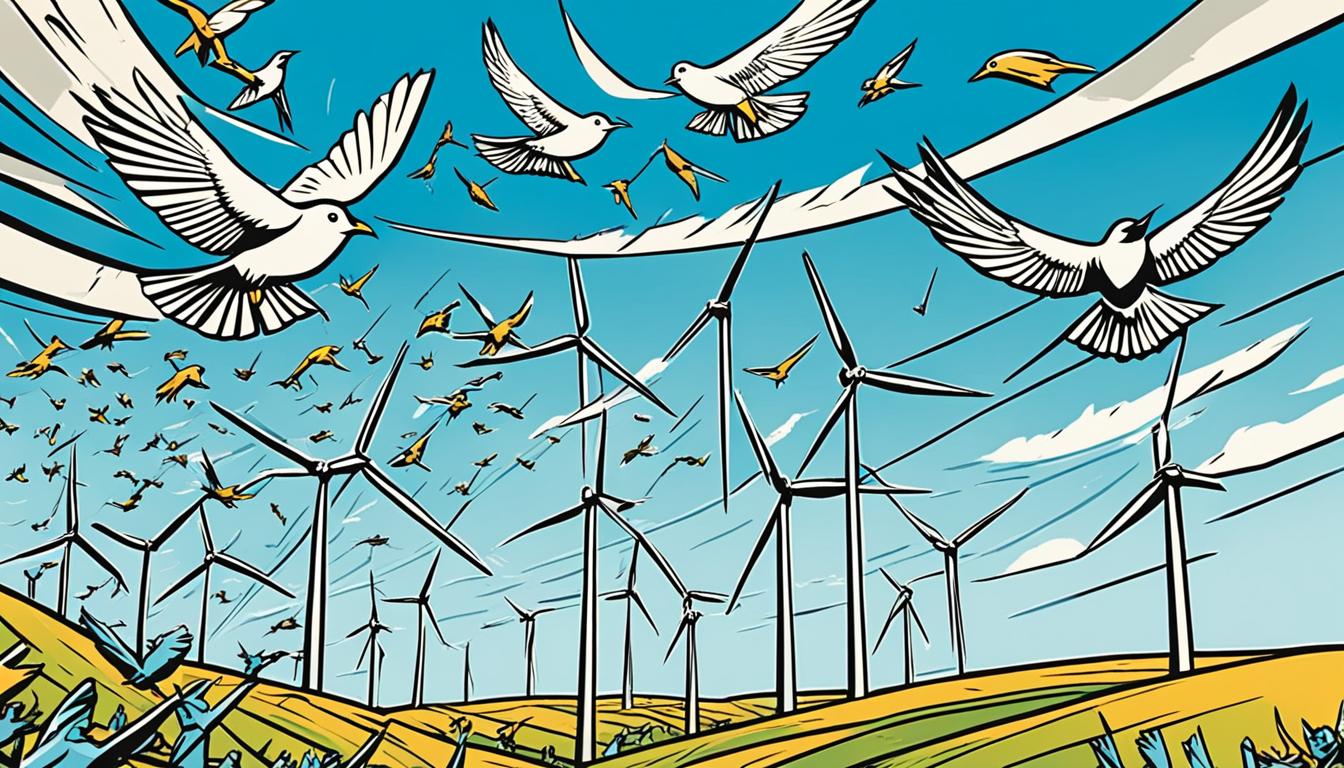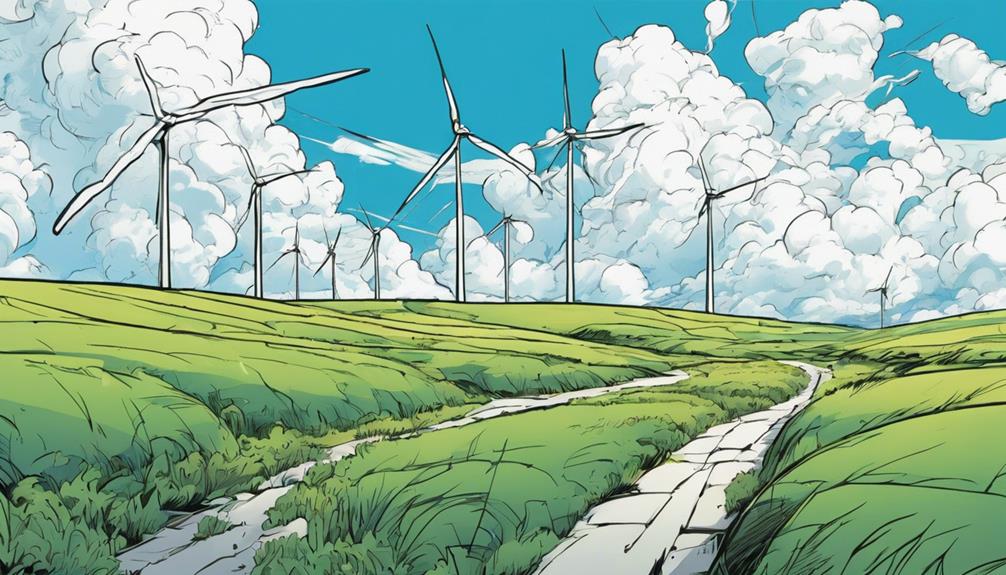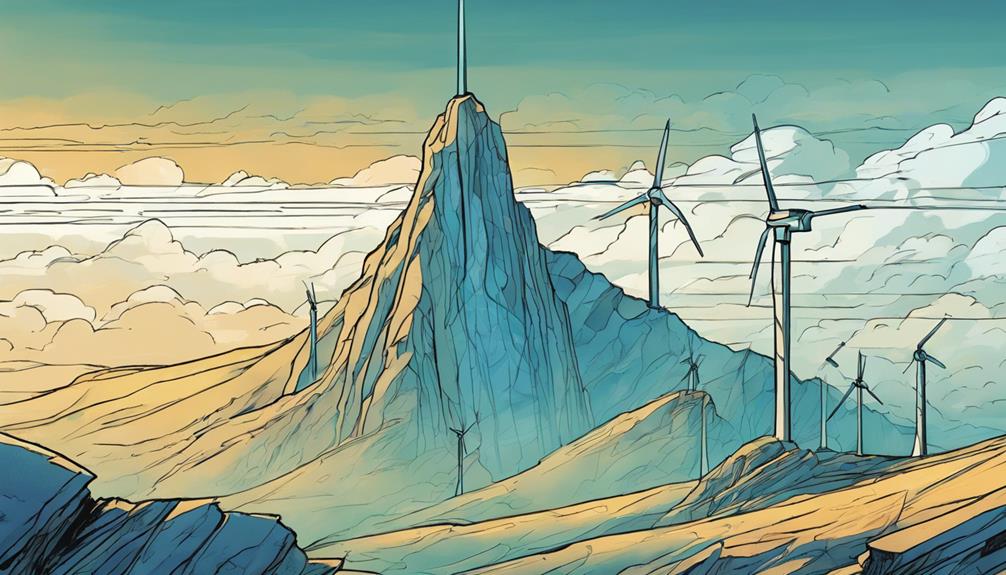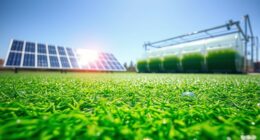In Australia, wind turbines cause over 10,000 bird deaths each year. Each turbine leads to four to six bird carcasses annually.
Wind energy is crucial for clean power but affects birds negatively. Wind turbines harm birds, including endangered ones, by causing collisions. They also disrupt bird habitats and displace them due to turbulence.
Key Takeaways:
- In North America, wind turbines are linked to hundreds of thousands of bird deaths yearly.
- They are also responsible for many bat deaths, with huge numbers in both Australia and North America.
- Adjusted wind speeds at turbines help lower bat deaths significantly.
- Techniques like ultrasonic deterrents and visual aids reduce bird and bat fatalities effectively.
- Audubon works with wildlife agencies to guide the safe use of wind turbines to protect birds.
Audubon backs wind energy to fight climate change but seeks responsible development. They want stronger laws and expert advice in turbine projects. Using smart strategies, we can balance energy needs with bird safety.
Wind energy is cost-effective and lowers carbon emissions. It’s vital to find locations for turbines that don’t harm birds or other wildlife3.
Audubon ensures turbine sites and operations consider bird safety. They promote wind power while protecting birds and wildlife.
Protecting birds while pursuing clean energy is crucial. With careful planning, new technology, and teamwork, wind energy can coexist with bird populations peacefully.
Key Takeaways:
- Wind power made up 7% of U.S. large-scale electric generation in 2019, with room to grow.
- Wind turbines cause 140,000 to 679,000 bird deaths in the U.S. each year.
- Wind facilities impact birds through collisions, damaging habitats, and displacement.
- Audubon leads in developing bird safety guidelines for wind turbine placement.
The Importance of Wind Power for Climate Change Mitigation
Audubon sees wind power as key to fighting climate change and moving towards green energy. It helps cut down emissions and battles climate harms. Wind energy is essential in our shift to sustainable energy sources.
Wind turbines create very little pollution, much less than gas or coal plants4. They produce between 0.02 and 0.04 pounds of carbon dioxide per kilowatt-hour. This is a big drop from the 0.6 to 3.6 pounds emitted by fossil fuels.
Wind energy is renewable and does not use up our planet’s resources. Over 73,000 turbines work in 43 states, indicating wind energy’s boom and acceptance5. These turbines stand tall on land, powering our homes cleanly.
Today’s wind turbines are giants, with the highest points reaching 500 feet. They grab wind’s kinetic energy to make electricity. This shows wind’s power to produce clean, sustainable energy5.
Climate change threatens all life, and wind turbines are made with wildlife in mind. Though some animals are affected, experts are looking for ways to reduce harm. Scientists and managers are seeking to lessen wind farms’ impacts on nature5.
Audubon backs wind energy to fight climate change and air pollution. Fossil fuels harm lower-income and minority communities more. Wind is a clean, cost-effective energy choice. Audubon works to ensure wind power is bird-friendly while addressing climate challenges56.
With wind energy growing, protecting birds is key. Wind farms cause fewer bird deaths compared to buildings or fossil fuels. Yet, about 140,000 to 328,000 birds die at wind farms annually. Efforts like curtailment and radar reduce bird deaths significantly. Some measures have cut vulture mortality by 92%6.
SpoorAI’s system has tracked over 126,000 birds, showing technology’s role in saving them. Power line markers also help, cutting collision risks by half6. These steps aim to make wind energy safer for birds.
Next, we’ll look into the challenges birds face from wind energy and the creative solutions being developed.
Risks Posed by Wind Energy to Birds
Wind energy helps fight climate change but poses risks to birds. Problems include direct strikes with turbines and habitat disturbances7.
America’s bird population has dropped nearly 30% since 1970, losing around 2.9 billion birds7. This decline highlights the need to consider wind energy’s impact carefully.
Wind turbines kill approximately 140,000 to 679,000 birds a year7. Still, cats and buildings cause more bird deaths. A study by Dr. Scott Loss showed 30 to 80 million stray cats in the US, against 44,577 wind turbines in 20127.
Certain birds are especially at risk from wind turbines. The Skookumchuck Wind facility could kill 85 Marbled Murrelets over 30 years7. In southern California, wind farms threaten Endangered California Condors7. These species reproduce slowly, making every loss severe7.
Turbine design improvements have lessened their impact on birds8. Modern turbines are bigger, more spaced out, and more efficient8. Offshore models also help prevent bird perching8. Comparatively, wind turbines are a minimal threat to most birds8.
Developers avoid areas important to birds8. Site surveys and monitoring help understand bird activities and risks at wind sites8. Technologies like ThermalTracker 3D and radio-frequency tags offer insights into bird movements8.
Developers follow U.S. Fish and Wildlife Service guidelines to minimize wildlife impacts8. These guidelines suggest various studies and monitoring stages8.
The American Bird Conservancy’s Bird-Smart Wind Energy program promotes responsible wind development7. Cooperation among conservationists, developers, and agencies aims to balance clean energy with bird protection78.
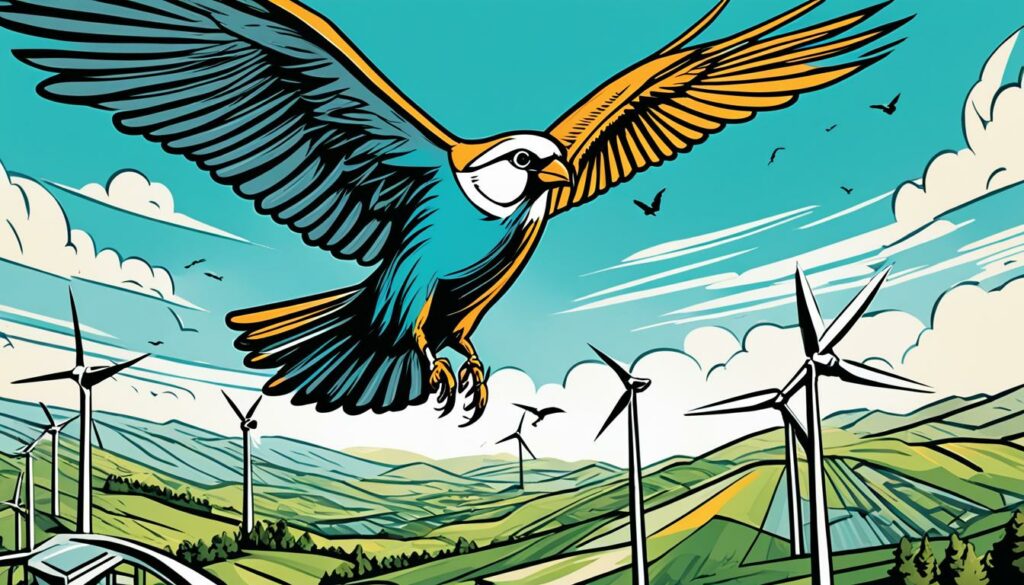
| Statistic | Fact |
|---|---|
| Bird population decline in the U.S. and Canada since 1970 | Approximately 30% decline, resulting in 2.9 billion fewer birds7 |
| Bird deaths due to wind turbine collisions annually | 140,000 to 679,000 bird deaths7 |
| Estimated number of unowned cats in the United States | Between 30 to 80 million cats7 |
| Estimated number of Marbled Murrelets killed over a 30-year term at the Skookumchuck Wind facility | 85 birds7 |
Mitigation Strategies for Wind Turbine and Birds
Audubon works hard to reduce wind turbines’ effects on birds. They focus on using areas with low impact on these animals, setting up wind farms correctly, inventing safe technologies, and using conservation efforts9. Their goal is to grow renewable energy and save bird species and their homes.
It’s vital to follow laws that protect wildlife and choose wind farm locations carefully. Avoiding areas with many birds or their migration paths is key9. Talking with wildlife experts helps find spots less likely to hurt bird life. This careful planning reduces bird accidents with turbines and keeps bird habitats safe.
Another key effort is creating new tools to keep birds and bats away from turbines9. Experts are always looking for better ways to prevent accidents, like using special sounds or signs. These innovations help birds stay safe while letting wind energy grow.
Adjusting turbine operations when birds are at risk also helps a lot. Slowing down turbines during high bird activity lowers accidents9. Tailoring measures for specific cases, like protecting bats or eagles, also works well in saving these animals9.
Understanding what increases collision risks is essential for better protection9. Knowing about bird migrations, behaviors, and where turbines are placed helps target protection efforts. This way, birds get the most protection without stopping wind energy’s benefits.
Siting wind farms smartly, using new safety technologies, and adapting operations are critical steps for bird safety. These actions help wind energy grow without harming our feathered friends. It’s about making sure our push for clean energy doesn’t harm nature.
Audubon’s Engagement in Wind Energy Siting and Operation
Audubon plays a key part in guiding where wind energy projects go. Their team, from the national level to local groups, works hard. They closely examine plans for wind projects to protect important animals and places10.Using technology and community support, Audubon shows the effects of these projects. They’ve spoken to Congress, worked with wildlife groups, and helped make rules for wind projects10.They also push for strict rules to protect nature while supporting wind energy10.
In leading wind project decisions, Audubon does a lot to protect wildlife and nature. Audubon Washington leads the way in picking places for solar power that keep wildlife and people happy10.At their Rowe Sanctuary, a clever use of UV light has cut down crane accidents with power lines10.
Working with the U.S. Fish and Wildlife Service, Audubon aims to protect California Condors from wind projects10.They stress fast action, smart placement, and bird-friendly tactics in their 2023 report to lessen harm10.
Audubon celebrated the start of a solar project in Washington state that avoids wildlife conflicts10.New rules under the Environmental Policy Act help them focus on community and climate benefits10. This benefits everyone: people, the climate, and birds10.
Audubon supports quickly setting up clean energy lines in the right places10.They rely on donations for their conservation efforts. They also share updates on renewable energy on their website for those interested10.
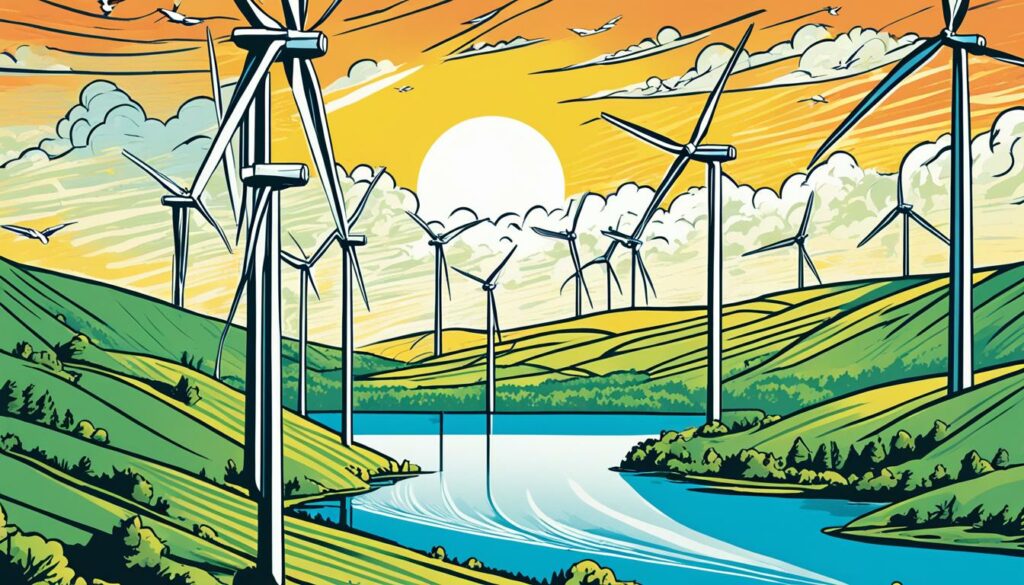
Select Audubon’s Involvement in Wind Energy Siting and Operation
| Initiative | Description |
|---|---|
| Utility-Scale PV Solar Siting | Identifying locations with minimal conflict to wildlife and communities in Washington state10 |
| Transmission Line Protection | Implementation of an ultraviolet light-based system reducing Sandhill Crane collisions at Rowe Sanctuary10 |
| Endangered Species Act Collaboration | Efforts with the U.S. Fish and Wildlife Service to prevent harm to California Condors at wind projects10 |
| Scientific Approaches | Emphasizing the importance of responsible siting and operation practices through scientific research10 |
| Least-Conflict Solar Project | Significant achievement in clean energy endeavors in Washington state10 |
Audubon’s work in wind energy shows their commitment to nature and clean energy10.They take various steps to ensure energy projects are done right11.This should be an example for the whole industry.
Wind Turbine Impact on Bird Mortality
Wind turbines cause some birds to die, but it’s a small part of a big problem. In the US, they’re responsible for less than one in 4,000 bird deaths caused by humans12. Compared to 25.5 million deaths from hitting power lines and 5.6 million from electrocutions, it’s less significant12.
Still, wind turbine-related deaths need our attention to help bird populations. In 2012, about 366,000 birds died because of turbines in the US12. This number might go up as we build more wind farms. Projections suggest we might see 538,000 to 681,000 bird deaths a year12.
However, the real number could be between 936,000 and 1.4 million birds annually when we account for counting mistakes12. This higher figure highlights the scale of the problem within the wider context of bird deaths by human actions.
Wind turbines don’t just kill birds directly. They also change habitats, force birds to move, and split up their living spaces12. Solving bird mortality means looking at all the ways we harm birds and fixing them together.

| Cause of Bird Mortality | Annual Estimate | Source |
|---|---|---|
| Wind Turbines | Estimate of approximately 366,000 birds killed in 2012 | 12 |
| Powerline Collisions | Approximately 25.5 million birds | 12 |
| Electrocutions | Additional 5.6 million birds | 12 |
Wind turbines do impact birds, but it’s part of a bigger issue of human-caused deaths. Working together and learning more can help protect birds at wind farms. The data we have might not even show the full impact because it’s incomplete12. By looking at the whole picture, we can aim for a balance between wind energy and protecting birds.
Innovative Solutions: Ultrasonic Drouble-Checks Deterrents and Visual Aids
Experts have found new ways to keep birds safe near wind farms. They use ultrasonic deterrents in Texas13. This technology makes sounds only birds hear. It steers them away from wind turbines. These methods are helping us save birds and bats while we produce wind energy.
Also, making turbine blades more visible helps birds avoid them. A technique is painting blades with eye-catching patterns13. This reduces bird accidents and makes wind farms safer for them. Researchers are always working to make these visual aids better for all bird types.
Another step forward uses laser tools as a visual warning14. Birds see the lasers and decide to leave. Adding sounds like gunshots or laughter can also keep birds away14. These tools combine sound and light to discourage birds from coming too close to turbines.
But, it’s important to use lasers carefully. We must ensure they don’t harm pilots or workers14. Protecting birds with visual aids needs to be done safely. As we use these new tools, balancing their benefits with risks is key.
| Innovative Bird Deterrents | Features |
|---|---|
| Bird Spider 360 | – Wind-powered movement – Startles birds and prevents landing – Ideal for boats, rooftops, and signs |
| Repeller 360 | – Spinning motion with reflective predator eyes – Covers areas up to 6 ft. in diameter – Easy installation |
| Bird Slope | – Unique angled design for narrow areas – Visually unobtrusive – Permanently installed using construction adhesive |
| Bird Spikes | – Simple yet effective deterrent – Harm-free protection from landing birds – Installed on ledges, rooftops, and railings |
Bird B Gone is at the forefront of creating bird-safe environments15. They offer advice and solutions tailored to specific situations. Their products are safe for birds and follow the law15.

Wind farms are getting better at lowering bird accidents by using these smart tools. This means birds are safer, and wind farms can still produce clean energy.
Collaboration and Incentivizing Mitigation Measures
Some wind energy companies work with scientists and take steps to protect birds. Still, we need more efforts across the board. Incentives for companies can drive them to care more for birds. This makes getting money for projects tied to protecting birds a must.
Working together is key to reducing the impact of wind turbines on birds. Government groups, energy companies, and conservationists need to join forces. This way, they can come up with and use strategies that work.
Germany is ahead with rules to protect birds from wind turbines. They require new turbines to lower risks to bats—a solid move towards wildlife safety. It shows how important laws and teamwork are for living things around us16.
Wind energy helps our planet by offering a clean power source. It fights climate change by cutting down pollution17. When wind companies and environmentalists work together, it’s a win-win. We get the energy we need without harming nature.
Governments can lead the way by offering money rewards to caring energy companies. These rewards can support bird-friendly technology or avoid construction in nesting times. Investing in innovative ideas like bird-safe turbine blades could save many birds16. Financial perks encourage companies to think about birds when building wind farms.
Being responsible with wind energy helps protect birds both rare and common. If energy companies, governments, and nature groups work together, we can find the right balance. This way, we make sure our push for clean energy does no harm.
Audubon’s Advocacy and Role in Wind Turbine-Bird Mitigation
Audubon is a key player in making wind turbines safer for birds. They work to balance the growth of renewable energy with bird protection. This ensures a healthy future for birds and humans alike.
By working with wind companies, Audubon helps plan projects that are safe for birds. They focus on placing turbines in areas that pose less risk to our feathered friends.
Audubon’s role goes beyond advising on projects. They have spoken in Congress to shape bird-safe guidelines for wind power. Teaming up with wildlife experts, they push for designs and operations that don’t harm birds.
Audubon stresses the importance of following wildlife protection laws in wind farm projects. Consulting with wildlife professionals early on helps avoid harming protected birds and the fines that can come with it.
To protect birds, developers use new tech like radar and cameras. These tools watch for birds and help keep endangered species, like condors and raptors, safe.
Audubon also argues that choosing the right locations for wind farms is key. Keeping turbines away from important bird areas cuts down on bird deaths and the need for expensive tech solutions.
Audubon encourages everyone involved in wind energy to work together. Through open dialogue, they find the best ways to protect birds while supporting renewable energy.
Reference:18

Audubon’s Contributions
| Audubon’s Contributions | Description |
|---|---|
| Advocacy in Congress | Testifying and lobbying for bird-friendly wind energy guidelines. |
| Collaboration | Working with wind developers, wildlife agencies, and conservation partners to implement bird mitigation measures. |
| Enforcement | Supporting the enforcement of existing laws and regulations to protect birds from wind turbine-related fatalities. |
| Technological Innovation | Promoting the use of cutting-edge technologies like radio detection and camera arrays to mitigate risks to bird species. |
| Proper Wind Farm Siting | Advocating for the careful selection of wind farm locations to minimize bird mortality and reduce the need for mitigation technologies. |
Conclusion
Wind turbines can create clean energy and fight climate change. They also reduce our need for fossil fuels. Yet, we must solve how they affect birds and find ways to lessen the risks.
Research shows wind farms don’t kill many birds, especially when compared to nuclear or fossil fuel plants19. With smart location and design, fewer birds are harmed by wind turbines1920. Groups like the Royal Society for the Protection of Birds and the American Bird Conservancy stress the need to understand these risks. They push for careful planning and rules for wind projects1920.
To help birds, it’s vital for different groups to work together1920. If we choose turbine sites carefully and turn them off when birds are most likely to pass by, we can save many birds19. New ideas, like sound systems and visual helpers, also seem to help prevent birds from hitting the turbines20.
By balancing wind energy’s benefits with protecting birds, we aim for a future where wind turbines don’t harm birds1920. Ongoing research, better turbine placement, and teamwork are key to wind energy’s success and bird safety.
